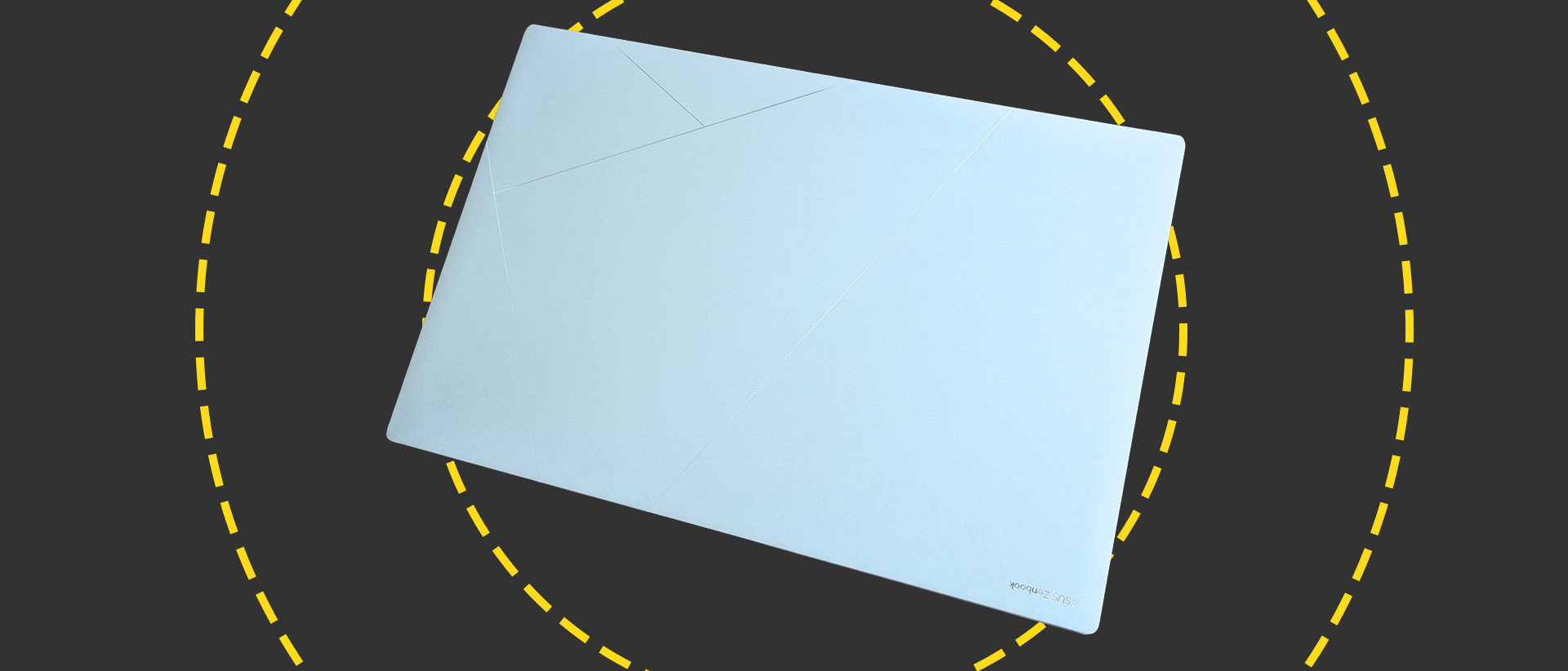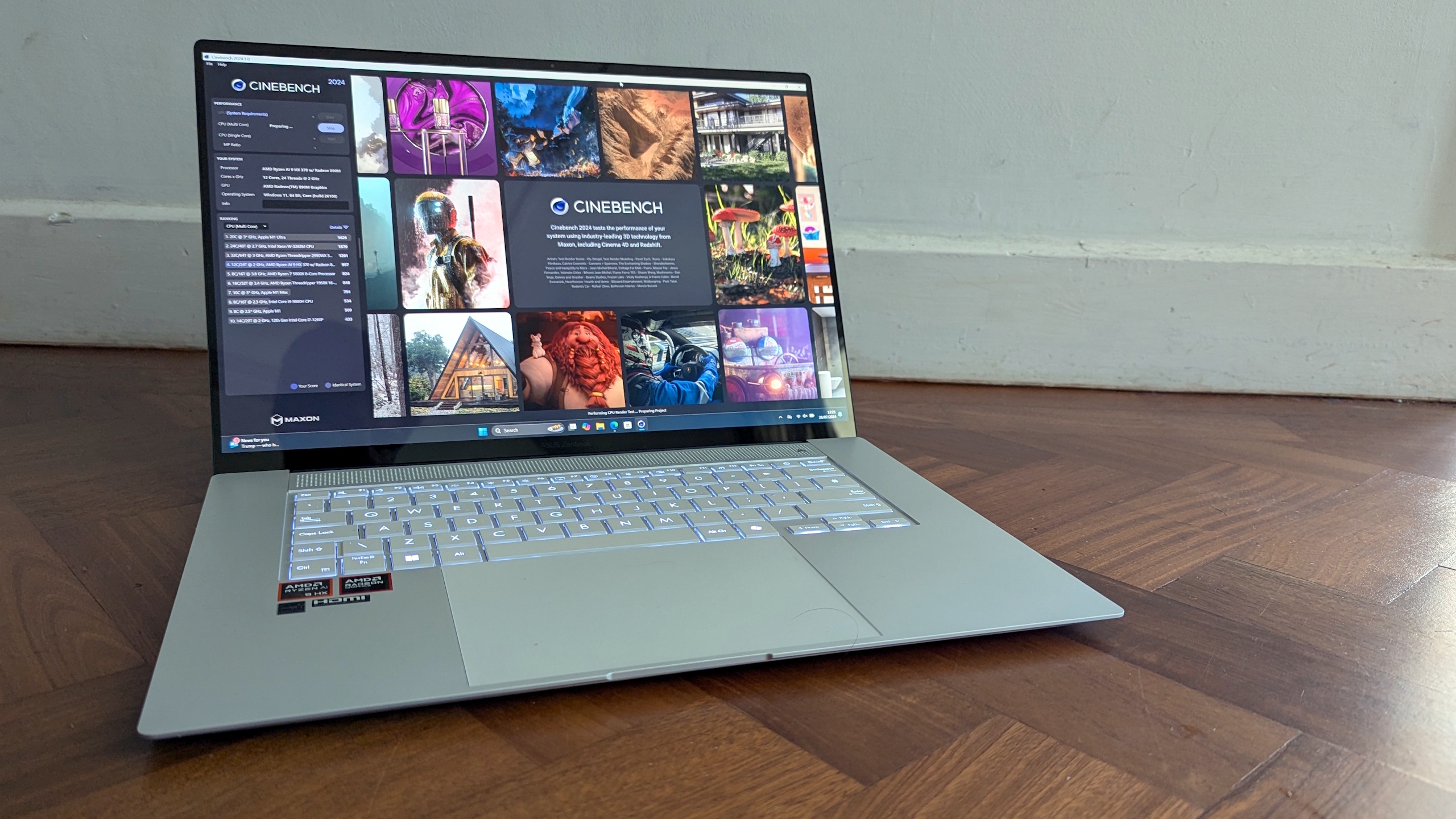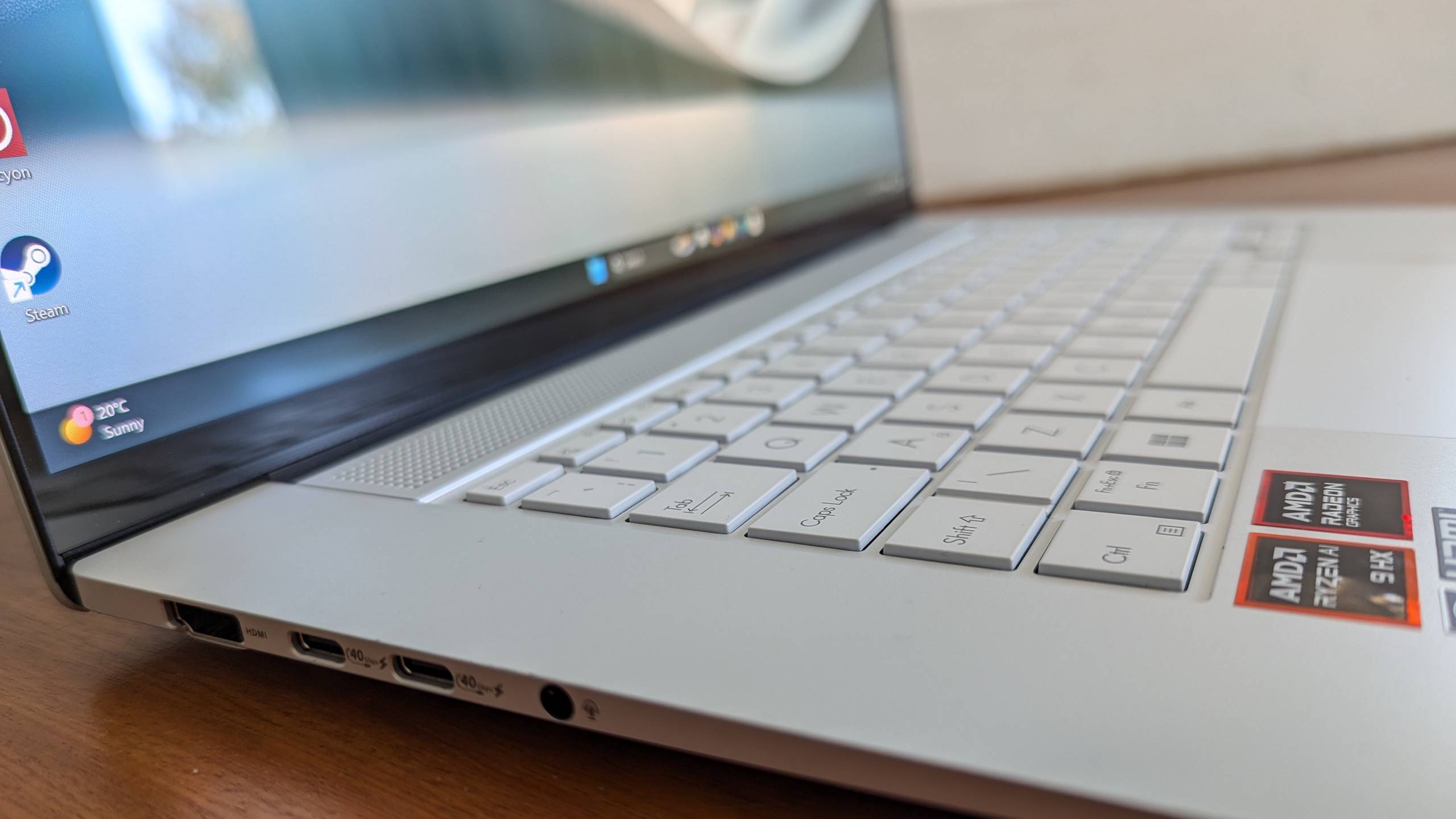Asus Zenbook S16 (UM5606) review: A stunning showcase for AMD's new AI tech
With impressive all-round performance and an excellent OLED screen, the new Zenbook S16 delivers fantastic value for business and creative pros

-
+
Strong all-round performance from Ryzen 9 HX 370
-
+
Excellent design and connectivity
-
+
Big and gorgeous OLED screen
-
+
Comfortable and responsive keyboard and touchpad
-
-
Rival CPUs can be faster in multi-core tests
-
-
Slightly noisier than equivalent Copilot+ PCs

Now that we've seen Intel's 'Meteor Lake' Core Ultra CPUs and Qualcomm's Snapdragon X Series, it's AMD's turn in the AI PC spotlight with its Ryzen AI 300 series processors, and the Ryzen 9 HX 370. AMD's first efforts in this sphere – the Ryzen Pro 7000 and 8000 series processors – were underwhelming, with performance from the chips' dedicated Neural Processing Unit (NPU) topping out at a mere 16 Tera Operations per Second (TOPS). That's substantially lower than the 40 TOPS required for Microsoft's Copilot+ PCs, and weedy compared to the 45 TOPS of the Hexagon NPU in the Snapdragon X Elite.
The Ryzen AI 9 HX 370 promises significant improvements, with its NPU dishing out up to 50 TOPS. WIth a 12-core/24-thread CPU based on AMD’s new Zen 5 architecture, plus an integrated Radeon 980M GPU, the Ryzen AI 9 HX 370 promises a lot of power for AI, graphics, and just about everything else.
And if AMD wants a showcase for its chip, it couldn't ask for much better than the Asus Zenbook S16. This is a beautiful, slim-and-light laptop with a massive screen and a strong set of features, and the Ryzen AI 9 HX 370 makes it significantly more versatile than the majority of laptops in its class. You could even position it as a serious competitor to the 16-inch Apple MacBook Pro, while costing close to £1,000 less.
Asus Zenbook S16: Design
Just about every laptop manufacturer has a premium thin-and-light line these days, and Asus isn't the first to marry the style to a bigger 16-inch display. With a desktop footprint of 353.6 x 243mm and a maximum thickness of just 11mm, you get a nice svelte profile but without impacting build quality or working comfort. Even with a spacious keyboard and a massive 15 x 10 cm trackpad, there's space for your palms to rest on either side. The base feels rock solid, as does the lid, and it's only underneath the base that you'll find any seams or edges, where they won't irritate you while you work away.
It's in the materials, though, that Asus pulls ahead of the pack. It's explored pseudo-ceramic materials before with Zenbooks and some Chromebooks, but the Zenbook S16 features a new Ceraluminium finish, giving you the toughness of an aluminum shell but with a more matt, ceramic finish. It looks and feels stunning in the Scandinavian White version I'm testing, especially with the white backlit keys and metallic geometric pattern on the lid.

The keys themselves are large, flat-topped chiclet efforts, and while they have a limited 1.1mm travel, the actual feel is nice and crisp. The layout is spoilt slightly by the small Shift and Ctrl keys on the left and single-height Enter key on the right, but everything else is just where you'd expect it, including the Copilot AI key next to the Alt Gr. Some might grumble about the half-height cursors, but at least they're separated from the rest of the keypad. Overall, I had no issues hitting my normal typing speed within a couple of hours.
The touchpad, meanwhile, is something of a triumph. Size alone isn't everything, but the space, smooth feel, and sensitivity give you real control when navigating apps, websites, or the Windows desktop, and there's even scope for more precise work in creative applications. The integral left and right clicks work flawlessly, or you can get away with single and double-fingered taps. Usability overall is top-notch.
Connectivity meets what we suspect is the new emerging standard, with two USB 4 Type-C ports, both with support for DisplayPort and USB-PD output, along with an HDMI 2.1 port and a single USB 3.2 Gen 2 Type A. Remember that one USB 4 Type-C will be occupied by the charger at least some of the time, but there's no desperate need to connect a dock unless you need Ethernet. With Wi-Fi 7 already onboard, that's not so likely, and you also have Bluetooth 5.4 if you need to connect a wireless mouse or headset.
Asus Zenbook S16: Display
The Ceraluminium finish is actually the second most attractive thing about the Zenbook S16, because the OLED screen steals first place. It's big and bright, with a 400 nit output for SDR content and 500 nits for HDR, and colors are as rich and vibrant as you could wish for. In tests, we measured SDR brightness levels a little lower – at 382.7n nits – but the screen still managed to display 100% of both the SRGB and DCI-P3 color gamuts, with gamut volumes of 172% and 122% respectively. It even reproduced 95.9% of the more demanding Adobe RGB color space. Thanks to OLED, you get infinite contrast, while color accuracy is exemplary, with an average Delta E of just 0.81. You don't need a display this good for mainstream business applications, but it'll easily handle more creative tasks as well.

The size and 2880 x 1800 resolution definitely help, though, when you're working across multiple windows on the desktop. You can keep the Scale to 150% or under, and make the most of Windows' split-screen views. Plus, if you want some entertainment when you're out on the road, the Zenbook S16 can easily accommodate you. Netflix looks fantastic on a screen this big.
The Zenbook S16 also has the audio to match, giving you a surprisingly full, powerful, and dynamic sound for music and entertainment, but also clarity and detail for voice and video calls. We were just as impressed with the output from the 1080p webcam, which captured crisp, well-exposed images in both natural and artificial light. And as the Zenbook S16 also features an infrared sensor, you get Windows Hello face recognition on top, signing us in instantly whenever we sit in front of the machine.
Asus Zenbook S16: Performance
So, how does the Ryzen AI 9 HX 370 perform? Well, it’s ready to trade blows with the Qualcomm and Intel competition, with results that are particularly impressive when you consider that the Zenbook S16 is using the chip in one of its lower 33W power configuration – the official TDP range runs from 15 to 54W.
In Geekbench 6 it comes out on top for single-core performance, with 2782 to 2405 from the Huawei Matebook X Pro with its Core Ultra 9 185H and 2427 from the Snapdragon X Elite-powered Asus Vivobook S15. In the multi-core tests, it only falls slightly behind, with 13508 compared to 13635 from the Matebook X Pro and 14337 from the Vivobook S15. However, it still pulls ahead of the Asus Vivobook Pro 15 OLED, which uses Intel’s Core Ultra 7 155H. Higher wattage variants will perform even better, so AMD’s new CPU shows plenty of promise.
Moving to the Cinebench R23 rendering benchmark, we don't have results for the Matebook X Pro, but here the Ryzen 9 HX 370 can't quite keep up with the Vivobook Pro 15 OLED’s Core Ultra 7 155H, scoring 15484 in the multi-threaded test against 16298. However, it scores a narrow win over the Qualcomm Snapdragon X Elite in Cinebench R24, with the Zenbook S16 scoring 957 to the Vivobook S15's 941.
RELATED WHITEPAPER

The Zenbook S16 also has the edge on 3D performance. The Radeon 980M GPU in the Ryzen AI 9 HX 370 scores 3725 in the 3DMark TimeSpy test and 580 in the new Steel Nomad benchmark, putting it ahead of the Vivobook S15, at 1848 and 495, by some distance. And, just in case you're interested, it's capable of running games like Cyberpunk 2077 at 32.2fps at 1080p with Medium settings, or 44.42fps with AMD's FSR upscaling tech. Try doing that on the Qualcomm or Intel competition.
As for AI performance, we're still experimenting with benchmarks, but the Ryzen 9 HX 370 machine scores an impressive 3308 in the Geekbench ML benchmark, against 2804 from the Vivobook S15 with its Snapdragon X Elite. In the Procyon Computer Vision benchmark the tables are turned, with the Zenbook S16 scoring 137 to the Vivobook S15's 1729. However, here the AMD chip needs to run under Microsoft's DirectML API, while Qualcomm's chip has its own Qualcomm SNPE library to rely on.
Overall, the Ryzen AI 9 HX 370 doesn't deliver a knockout blow to Intel or Qualcomm, especially at this wattage, but it's very competitive and arguably more rounded, delivering strong performance across its CPU, GPU and NPU. In everyday use, we found performance in productivity and creative apps exemplary, with the whole experience feeling slick and polished. However, there are two caveats. Firstly, Microsoft's Copilot+ enhancements for Windows 11 are currently exclusive to Qualcomm-powered laptops, so if you're bothered about Microsoft's image-generation and video call features, they're out of reach right now on an AMD machine. Secondly, the Zenbook S16 is noisier than any Snapdragon X Elite laptops I've tested. It only puts out around 29dB when pushed, but the Vivobook S15 is virtually silent.
Asus Zenbook S16: Is it worth it?
Yes. This is a stunning laptop with a fantastic OLED screen, and while AMD's new processor can't quite match the competition in some specific areas of performance, it gives you a compelling package of CPU, GPU and NPU power. We're still waiting for more applications to really take advantage of hardware AI acceleration, but the Ryzen AI 9 HX 370 looks like a solid bet when they emerge. In the meantime, the Zenbook S16 is a treat to use in the applications you're already working with.
Acer Zenbook S16 specifications
| Display | 16-inch 2,880 x 1,800 OLED, 120Hz refresh rate |
| Processor | AMD Ryzen AI 9 HX 370 |
| GPU | AMD Radeon 890M |
| RAM | 32GB LPDDR5 |
| Ports | 2x Thunderbolt 4/USB 4, 2x USB-A 3.2 Gen 2, HDMI 2.1, SD card reader |
| 3.5mm audio jack | Yes |
| Camera | 1080p webcam + Windows Hello IR |
| Storage | 1TB PCIe4 SSD |
| Connectivity | Wi-Fi 7, Bluetooth v5.3 |
| Weight | 1.5Kg |
| Dimensions | 353.6 x 243 x 11mm |
| Battery Capacity | 78Wh |
| Operating System | Windows 11 Home |
Get the ITPro daily newsletter
Sign up today and you will receive a free copy of our Future Focus 2025 report - the leading guidance on AI, cybersecurity and other IT challenges as per 700+ senior executives
Stuart has been writing about technology for over 25 years, focusing on PC hardware, enterprise technology, education tech, cloud services and video games. Along the way he’s worked extensively with Windows, MacOS, Linux, Android and Chrome OS devices, and tested everything from laptops to laser printers, graphics cards to gaming headsets.
He’s then written about all this stuff – and more – for outlets, including PC Pro, IT Pro, Expert Reviews and The Sunday Times. He’s also written and edited books on Windows, video games and Scratch programming for younger coders. When he’s not fiddling with tech or playing games, you’ll find him working in the garden, walking, reading or watching films.
You can follow Stuart on Twitter at @SATAndrews.
-
 ‘Phishing kits are a force multiplier': Cheap cyber crime kits can be bought on the dark web for less than $25 – and experts warn it’s lowering the barrier of entry for amateur hackers
‘Phishing kits are a force multiplier': Cheap cyber crime kits can be bought on the dark web for less than $25 – and experts warn it’s lowering the barrier of entry for amateur hackersNews Research from NordVPN shows phishing kits are now widely available on the dark web and via messaging apps like Telegram, and are often selling for less than $25.
By Emma Woollacott Published
-
 Redis unveils new tools for developers working on AI applications
Redis unveils new tools for developers working on AI applicationsNews Redis has announced new tools aimed at making it easier for AI developers to build applications and optimize large language model (LLM) outputs.
By Ross Kelly Published
-
 Google layoffs continue with "hundreds" cut from Chrome, Android, and Pixel teams
Google layoffs continue with "hundreds" cut from Chrome, Android, and Pixel teamsNews The tech giant's efficiency drive enters a third year with devices teams the latest target
By Bobby Hellard Published